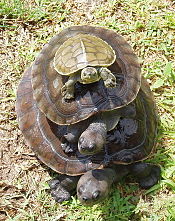| Revision as of 00:42, 29 May 2012 editAnomieBOT (talk | contribs)Bots6,583,614 editsm Dating maintenance tags: {{Cn}}← Previous edit | Revision as of 13:16, 31 May 2012 edit undoRich Farmbrough (talk | contribs)Edit filter managers, Autopatrolled, Extended confirmed users, File movers, Pending changes reviewers, Rollbackers, Template editors1,725,884 editsNo edit summaryNext edit → | ||
| Line 7: | Line 7: | ||
| | phylum = ] | | phylum = ] | ||
| | classis = ] | | classis = ] | ||
| | ordo = ] | | ordo = ] | ||
| | subordo = ] | | subordo = ] | ||
| | superfamilia = ] | | superfamilia = ] | ||
| Line 32: | Line 32: | ||
| ==Reproduction== | ==Reproduction== | ||
| Mating behaviour |
Mating behaviour appears to be triggered by rain; in captivity spraying males with water results in them chasing females and attempting to mount. Nothing is known of nesting behaviour in the wild. One or two, rarely three, eggs are laid per clutch, in captivity laying usually occurring in the night or early morning. Females produce up to three clutches per year. A ] hinge develops to ease laying. Three captive incubations have succeeded with durations of 106, 110 and 145 days.<ref>http://www.torontozoo.com/ExploretheZoo/AnimalDetails.asp?pg=694</ref> | ||
| ==References== | ==References== | ||
| Line 39: | Line 39: | ||
| ;Bibliography | ;Bibliography | ||
| *{{Anchor|CITEREFRhodin2011}}{{cite journal | url = http://www.iucn-tftsg.org/wp-content/uploads/file/Accounts/crm_5_000_checklist_v4_2011.pdf | title = Turtles of the world, 2011 update: Annotated checklist of taxonomy, synonymy, distribution and conservation status |journal=Chelonian Research Monographs|volume=5|year = 2011 | accessdate =|date=2011-12-31 | author=Rhodin, Anders G.J.; van Dijk, Peter Paul; Inverson, John B.; Shaffer, H. Bradley; Roger, Bour| archiveurl = http://www.webcitation.org/64t6NrOyR | archivedate = 2012-01-22}} | *{{Anchor|CITEREFRhodin2011}}{{cite journal | url = http://www.iucn-tftsg.org/wp-content/uploads/file/Accounts/crm_5_000_checklist_v4_2011.pdf | title = Turtles of the world, 2011 update: Annotated checklist of taxonomy, synonymy, distribution and conservation status |journal=Chelonian Research Monographs|volume=5|year = 2011 | accessdate =|date=2011-12-31 | author=Rhodin, Anders G.J.; van Dijk, Peter Paul; Inverson, John B.; Shaffer, H. Bradley; Roger, Bour| archiveurl = http://www.webcitation.org/64t6NrOyR | archivedate = 2012-01-22}} | ||
| *{{Anchor|CITEREFFritz2007}}{{cite journal | journal = |
*{{Anchor|CITEREFFritz2007}}{{cite journal | journal = Vertebrate Zoology | title = Checklist of chelonians of the world | year = 2007 | first = Uwe | last = Fritz | coauthors = Havaš, Peter | volume = 57 | issue = 2 | pages = | id = | url = http://www.cnah.org/pdf_files/851.pdf | archiveurl = http://www.webcitation.org/5v20ztMND | archivedate = 2010-12-17}} | ||
| ==External links== | ==External links== | ||
| Line 45: | Line 45: | ||
| {{Geoemydidae}} | {{Geoemydidae}} | ||
| {{Use dmy dates|date=May 2012}} | |||
| ] | ] | ||
| ] | ] | ||
Revision as of 13:16, 31 May 2012
| Spiny turtle | |
|---|---|
| Conservation status | |
 Endangered (IUCN 2.3) | |
| Scientific classification | |
| Kingdom: | Animalia |
| Phylum: | Chordata |
| Class: | Sauropsida |
| Order: | Testudinesa |
| Suborder: | Cryptodira |
| Superfamily: | Testudinoidea |
| Family: | Geoemydidae |
| Genus: | Heosemys |
| Species: | H. spinosa |
| Binomial name | |
| Heosemys spinosa Gray, 1830 | |
| Synonyms | |
| |
The spiny turtle (Heosemys spinosa) inhabits lowland and hill rainforest, usually in the vicinity of small streams, mainly in hill areas up to 900 m.
Description
The origin of its common and specific name is immediately apparent from the sharp, pointed, spiky-edged carapace, and spiny keel, of this unique turtle, also known as the ‘cog-wheel turtle'.
Distrubution
The spiny turtle is known from Brunei, Indonesia, Malaysia, Myanmar, the Philippines, Singapore, and Thailand.
Reproduction
Mating behaviour appears to be triggered by rain; in captivity spraying males with water results in them chasing females and attempting to mount. Nothing is known of nesting behaviour in the wild. One or two, rarely three, eggs are laid per clutch, in captivity laying usually occurring in the night or early morning. Females produce up to three clutches per year. A plastron hinge develops to ease laying. Three captive incubations have succeeded with durations of 106, 110 and 145 days.
References
- ^ Rhodin 2011, p. 000.190
- Template:IUCN
- Fritz 2007, p. 224 harvnb error: multiple targets (2×): CITEREFFritz2007 (help)
- http://www.torontozoo.com/ExploretheZoo/AnimalDetails.asp?pg=694
- Bibliography
- Rhodin, Anders G.J.; van Dijk, Peter Paul; Inverson, John B.; Shaffer, H. Bradley; Roger, Bour (31 December 2011). "Turtles of the world, 2011 update: Annotated checklist of taxonomy, synonymy, distribution and conservation status". Chelonian Research Monographs. 5. Archived from the original (PDF) on 22 January 2012.
{{cite journal}}: CS1 maint: date and year (link) CS1 maint: multiple names: authors list (link) - Fritz, Uwe (2007). "Checklist of chelonians of the world". Vertebrate Zoology. 57 (2). Archived from the original (PDF) on 17 December 2010.
{{cite journal}}: Unknown parameter|coauthors=ignored (|author=suggested) (help)
External links
| Family Geoemydidae | ||||
|---|---|---|---|---|
| ||||
| Genera |
|  | ||
| †Banhxeochelys | ||||
| Batagur | ||||
| Cuora | ||||
| Cyclemys | ||||
| †Echmatemys | ||||
| Geoclemys | ||||
| Geoemyda | ||||
| Hardella | ||||
| Heosemys | ||||
| Leucocephalon | ||||
| Malayemys | ||||
| Mauremys | ||||
| Melanochelys | ||||
| Morenia | ||||
| Notochelys | ||||
| Orlitia | ||||
| Pangshura | ||||
| Rhinoclemmys | ||||
| Sacalia | ||||
| Siebenrockiella | ||||
| Vijayachelys | ||||
| Phylogenetic arrangement of turtles based on turtles of the world 2017 update: Annotated checklist and atlas of taxonomy, synonymy, distribution, and conservation status. †=Extinct. | ||||
This article about a turtle is a stub. You can help Misplaced Pages by expanding it. |